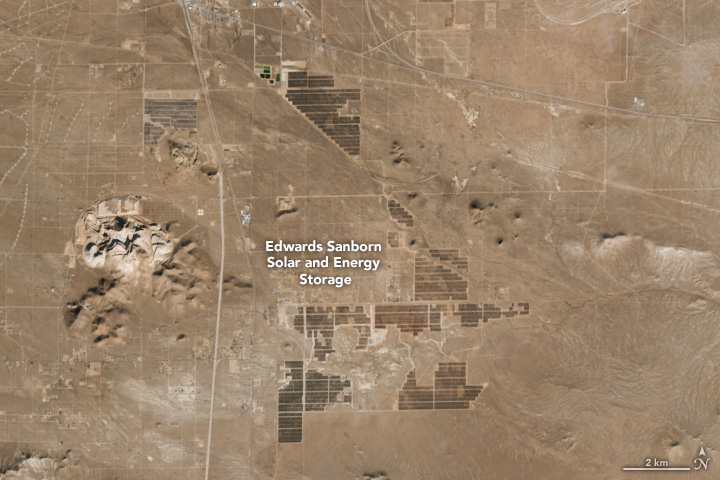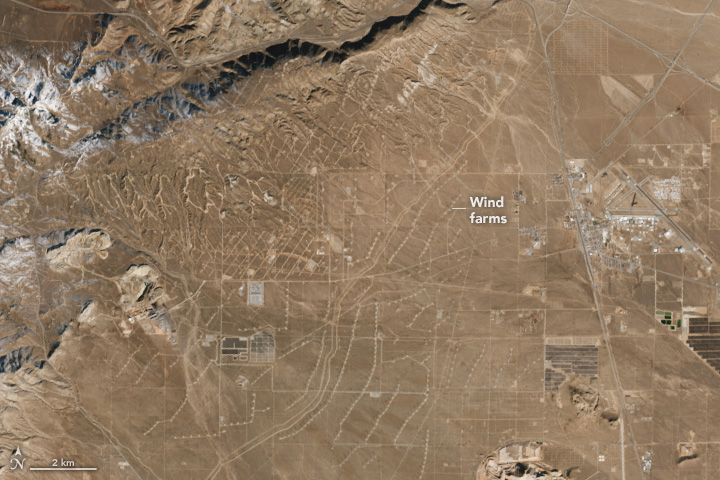
Solar and Batteries Go Big in the Desert
Downloads
- solarstorage_oli2_20240112_lrg.jpg (1284x856, JPEG)
- windfarms_oli2_20240112_lrg.jpg (720x480, JPEG)
Metadata
- Sensor(s):
- Landsat 9 - OLI-2
- Data Date: January 12, 2024
- Visualization Date: February 2, 2024
Discussions of solar energy can be quick to point out its intermittent nature: the Sun does not always shine in any one place all the time. It does, however, shine quite a bit in the Mojave Desert in California. And as it happens, the Mojave is the location of a large new solar power plant integrated with battery storage. The Edwards Sanborn Solar and Energy Storage project incorporates the highest capacity solar farm in the United States with the largest battery storage system in the world.
The facility came online in February 2023 and became fully operational in January 2024. The OLI-2 (Operational Land Imager-2) on Landsat 9 captured this image of the project and its nearly 2 million solar panels on January 12, 2024. The site lies approximately 60 miles (100 kilometers) north of Los Angeles, in an area of the U.S. with some of the largest amounts of solar energy reaching the ground.
The plant straddles private and federal land, taking advantage of an enhanced use lease program to develop underutilized land on Edwards Air Force Base. Just over half of the panels are located on the base and the rest are on private land. The project has been described as the largest public-private collaboration in U.S. Department of Defense history.
Edwards Sanborn has 875 megawatts of solar capacity, the highest of any facility in the U.S. Additionally, to mitigate intermittency issues, it incorporates a battery energy storage system with 3,300 megawatt-hours of capacity, surpassing the Moss Landing Energy Storage Facility as the largest battery storage system in the world. The project supplies power to California utilities, the city of San Jose, the Clean Power Alliance, and several corporations.
This corner of the desert is a hotbed not only for solar but also for wind energy. Rows of wind turbines, connected by both straight and sinuous access roads, are visible in the stretch of desert northwest of the solar-plus-storage project (above). This image was also acquired by the OLI-2 on Landsat 9 on January 12, 2024.
The wind farms are positioned to take advantage of reliable winds, which come off the Pacific Ocean and funnel through Tehachapi Pass. Winds accelerate as they flow through the mountain pass in a phenomenon known as the Venturi effect. Operating in this area, the Alta Wind Energy Center is among the largest onshore wind farms in the U.S.
A history of innovation and superlatives is baked into this part of the Mojave. NASA’s Armstrong Flight Research Center is also located on Edwards Air Force Base, to the east of the area shown in this scene. It was here, for example, in 1947 that the X-1 became the first piloted aircraft to break the sound barrier. Armstrong will serve as the base of operations for the X-59 quiet supersonic research aircraft, which debuted in January 2024.
References
- Bakersfield.com (2023, February 8) Solar energy project extending onto Edwards Air Force Base becomes Kern’s largest. Accessed February 1, 2024.
- CleanTechnica (2023, February 6) Edwards AFB Solar & Battery Storage Project Goes Live. Accessed February 1, 2024.
- Edwards Air Force Base (2023, February 6) Largest Private-Public Collaboration in Department of Defense History Reflects Commitment to Clean Energy. Accessed February 1, 2024.
- Energy-Storage.news (2024, January 24) California solar-plus-storage project with world’s largest BESS fully online. Accessed February 1, 2024.
- Mortenson Edwards & Sanborn Solar and Energy Storage. Accessed February 1, 2024.
- NASA The POWER Project. Accessed February 1, 2024.
- NASA Earth Observatory (2019, September 17) Cameron Ridge. Accessed February 1, 2024.
- NASA Earth Observatory (2019, April 23) Pushing Limits at Armstrong Flight Research Center. Accessed February 1, 2024.
NASA Earth Observatory images by Wanmei Liang, using Landsat data from the U.S. Geological Survey. Story by Lindsey Doermann.
This image record originally appeared on the Earth Observatory. Click here to view the full, original record.
